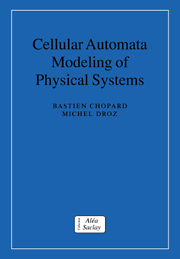7 - Other models and applications
Published online by Cambridge University Press: 26 October 2009
Summary
This chapter presents a few more applications of the cellular automata and lattice Boltzmann techniques. We introduce some new ideas and models that have not been discussed in detail previously and which can give useful hints on how to address different problems.
We shall first discuss a lattice BGK model for wave propagation in a heterogeneous media and show how it can be applied to simulate a fracture process or make predictions for radio wave propagation inside a city. Second, we shall present how van der Waals and gravity forces can be included in an FHP cellular automata fluid in order to simulate the spreading of a liquid droplet on a wetting substrate. Then, we shall define a multiparticle fluid with a collision operator inspired by the lattice BGK method in order to avoid numerical instabilities and re-introduce fluctuations in a natural way. Finally, we shall explain how particles in suspension can be transported and eroded by a fluid flow and deposited on the ground. Snowdrift and sand dunes formation is a typical domain where this last model is applicable.
Wave propagation
One-dimensional waves
In this book, we have already encountered one-dimensional wave propagation. The chains of particles, or strings, discussed in section 2.2.9 move because of their internal shrinking and stretching. From a more physical point of view, this internal motion is mediated by longitudinal backward and forward deformation waves.
- Type
- Chapter
- Information
- Cellular Automata Modeling of Physical Systems , pp. 256 - 312Publisher: Cambridge University PressPrint publication year: 1998



